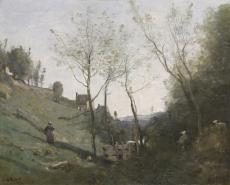


Jean-Baptiste-Camille Corot, whose career began around 1820, was declared by mid-century the leader of the French landscape school and remained a major figure in the Parisian art scene until his death in 1875, at which time Impressionism began to take shape. His initial training was strongly marked by his sojourn, between 1825 and 1828, in Italy, where he returned in 1834 and again in 1843. His conception of the landscape remained anchored in academic tradition; he painted sketches from nature, which he would then return to and work on in his studio. He was also one of the first painters to work assiduously in the Forest of Fontainebleau, much like his friend Théodore Rousseau (1812-1867) and the painters of the Barbizon School. His career was punctuated by many voyages in France and abroad (the Low Countries, 1854; Britain, 1862), which supplied him with renewed subject matter. Despite populating his compositions with nymphsand mythological references, Corot remained essentially a landscape artist in the eyes of his contemporaries. The portraits and, above all, the figures he painted towards the end of his life were known only to a small group of admirers, the same, in fact, who would go on to attach themselves to the Impressionists. All the Impressionists appreciated the candour of his vision, the freedom of his painting, his sensibility before nature, his sense of light and his modesty. Amongst them, Camille Pissarro (1830-1903) and Berthe Morisot (1841-1895) received personal advice from the master. On the other hand, faithful to his idealised vision of the world, Corot did not let himself be won over by the realism of Gustave Courbet (1819-1877) or his emulators.
Beginning in 1827, the artist regularly exhibited his work at the Paris Salon, receiving his share of eulogies as well as critiques. His admirers were sensible to his poetry and his subtle palette; his detractors reproached him for a certain awkwardness and the use of dull, grey colours. Vexed with official art circles, Corot was somewhat vindicated when Napoleon III bought one of his landscapes, Souvenir de Marcoussis (Paris, Musée d’Orsay), at the Exposition Universelle of 1855.
La Vallée aux Chèvres (Soleil Levant), a canvas dated 1868 by the specialist and author of Corot’s catalogue raisonné, Alfred Robaut, belongs to the end of the painter’s career. In 1867, Corot was made an officer of the Légion d’honneur, a distinction which confirmed his national stature. After an episode of poor health, he resumed his peregrinations through France. However, it is not possible to identify precisely the site depicted in this work, even though the steep slope, which permits the landscape to open onto a vast sky, is sufficiently distinctive. The profile of the house roofs evokes the French countryside, and the small silhouette of a peasant woman at the foot of the slope is not one of an Italian goatherd, like the ones the old artist recalled when painting Souvenir de Lac d’Albano, Italie (Reims, Musée des Beaux-Arts), while at the same time working on studies carried out around Beauvais, a region which was familiar to him. Corot’s compositions from this period are, in any case, filled with reminiscences, and the absence of points of reference contributes to this idealistic approximation, which pleased his contemporaries and continues to enchant us by its atemporal simplicity. The artist often painted agile goats, whose slight silhouettes introduce a carefree note, in contrast to the sobriety of the representation. As for the large trees of lissom figure and meagre foliage profiled against a pale sky, they are in a way the artist’s signature. Their sinewy lines, forming a first plane, which is both moving and discontinuous, encourage the eye of the viewer to discover the space just up to the horizon enclosed by grey hills. According to Robaut, this painting was given by Corot to Paul Dutilleux, the son of his friend, the artist Constant Dutilleux (1807-1865), most likely soon after its completion; however, by the early 20th century, it was already in America, where Corot soon became a much sought-after master.
A master of creating delicate and luminous landscapes in a restrained palette, he was a leading figure of the French landscape school by the mid-19th century. At the age of 26 he was given a small allowance to pursue art training. He studied under the classical landscapists Achille-Etna Michallon and Jean-Victor Bertin and then spent three years in Italy. His notion of landscape remained fixed in academic tradition; yet he paved the way for the Impressionist landscape painters, on whom he exerted a great influence. He made small oil sketches and drawings from nature, which he would then work up in his studio.